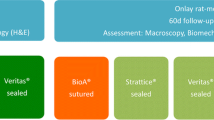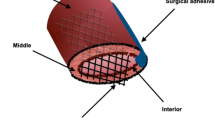Abstract
Purpose
The objective of this study was to evaluate the histologic remodeling profile and biomechanical properties of the porcine abdominal wall after repair with HDMI-crosslinked (Permacol®) or non-crosslinked (Strattice®) porcine dermis in a porcine model of ventral hernia repair.
Methods
Bilateral incisional hernias were created in Yucatan minipigs and repaired after 21 days. The repair site, including mesh and abdominal wall, was harvested after 1, 6, and 12 months and subjected to histologic analysis and uniaxial testing. Native abdominal wall without mesh was also subjected to uniaxial tensile testing.
Results
Permacol® demonstrated significant improvement over time in every remodeling category except scaffold degradation, while remodeling characteristics of Strattice® remained relatively unchanged over time for every category except fibrous encapsulation and neovascularization. However, remodeling scores for Strattice® were already significantly higher after just 1 month compared to Permacol® in the categories of cellular infiltration, ECM deposition, and neovascularization, providing evidence of earlier remodeling of the non-crosslinked grafts compared to the crosslinked grafts. The tensile strength and stiffness of both crosslinked and non-crosslinked graft-tissue composites were greater than the tensile strength and stiffness of the native porcine abdominal wall in the very early post-operative period (1 month), but there was no difference in tensile strength or stiffness by the end of the study period (12 months).
Conclusions
HDMI collagen crosslinking of porcine dermis scaffolds reduces the early histologic remodeling profile but does not significantly impact the tensile strength or stiffness of the graft-tissue composites in a porcine model of ventral hernia repair.



Similar content being viewed by others
References
Millennium Research Group (2010) US markets for soft tissue repair devices. Millennium Research Group Incorporated, Toronto
Harth KC, Broome AM, Jacobs MR, Blatnik JA, Zeinali F, Bajaksouzian S, Rosen MJ (2011) Bacterial clearance of biologic grafts used in hernia repair: an experimental study. Surg Endosc 25(7):2224–2229
Kim H, Bruen K, Vargo D (2006) Acellular dermal matrix in the management of high-risk abdominal wall defects. Am J Surg 192(6):705–709
Patton JH Jr, Berry S, Kralovich KA (2007) Use of human acellular dermal matrix in complex and contaminated abdominal wall reconstructions. Am J Surg 193(3):360–363
Maurice SM, Skeete DA (2009) Use of human acellular dermal matrix for abdominal wall reconstructions. Am J Surg 197(1):35–42
Cornwell KG, Landsman A, James KS (2009) Extracellular matrix biomaterials for soft tissue repair. Clin Podiatr Med Surg 26(4):507–523
Badylak SF, Freytes DO, Gilbert TW (2009) Extracellular matrix as a biological scaffold material: structure and function. Acta Biomater 5(1):1–13
Badylak SF (2007) The extracellular matrix as a biologic scaffold material. Biomaterials 28(25):3587–3593
Badylak SF (2004) Xenogeneic extracellular matric as a scaffold for tissue reconstruction. Transpl Immunol 23(3–4):367–377
Klinge U, Si ZY, Zheng H, Schumpelick V, Bhardwaj RS, Klosterhalfen B (2000) Abnormal collagen I to III distribution in the skin of patients with incisional hernia. Eur Surg Res 32(1):43–48
Liang HC, Chang Y, Hsu CK, Lee MH, Sung HW (2004) Effects of crosslinking degree of an acellular biologic tissue on its tissue regeneration pattern. Biomaterials 25(17):3541–3552
Committee on Care and Use of Laboratory Animals, U.S. Department of Health and Human Services, Public Health Service (1996). National Institutes of Health, Bethesda, MD
de Castro Bras LE, Proffitt JL, Bloor S, Sibbons PD (2010) Effect of crosslinking on the performance of collagen-derived biomaterial as an implant for soft tissue repair: a rodent model. J Biomed Mater Res B Appl Biomater 95(2):239–249
International consensus (2010) Acellular matrices for the treatment of wounds. An expert working group review. Wounds International, London
Permacol® Surgical Implant: Instructions for Use (2007). Tissue Science Laboratories, Incorporated, Andover. www.tissuescience.com
Strattice® Reconstrutive Tissue Matrix: Instructions for Use (2008). LifeCell Corporation, Branchburg. http://www.lifecell.com/downloads/StratticeIFU_T11.pdf
Jenkins ED, Melman L, Desai S, Brown SR, Frisella MM, Deeken CR, Matthews BD (2011) Evaluation of intraperitoneal placement of absorbable and nonabsorbable barrier coated mesh secured with fibrin sealant in a New Zealand white rabbit model. Surg Endosc 25(2):604–612
Melman L, Jenkins ED, Hamilton NA, Bender LC, Brodt MD, Deeken CR, Greco SC, Frisella MM, Matthews BD (2011) Early biocompatibility of crosslinked and non-crosslinked biologic meshes in a porcine model of ventral hernia repair. Hernia 15(2):157–164
Deeken CR, Melman L, Jenkins ED, Greco SC, Frisella MM, Matthews BD (2011) Histologic and biomechanical evaluation of crosslinked and non-crosslinked biologic meshes in a porcine model of ventral incisional hernia repair. J Am Coll Surg 212(5):880–888
Valentin JE, Badylak JS, McCabe GP, Badylak SF (2006) Extracellular matrix bioscaffolds for orthopaedic applications: a comparative histologic study. J Bone Joint Surg Am 88(12):2673–2686
Acknowledgments
This research was supported by a grant from Synovis Surgical Innovations, Inc., St. Paul, MN. This data were presented at Hernia Repair 2011, American Hernia Society, San Francisco, California, March 18, 2011. Funding for this project was provided by Synovis Surgical Innovations, Inc. (St. Paul, MN).
Conflict of interest
B.D.M. declares having received funds in relation with this study.
Author information
Authors and Affiliations
Corresponding author
Rights and permissions
About this article
Cite this article
Cavallo, J.A., Greco, S.C., Liu, J. et al. Remodeling characteristics and biomechanical properties of a crosslinked versus a non-crosslinked porcine dermis scaffolds in a porcine model of ventral hernia repair. Hernia 19, 207–218 (2015). https://doi.org/10.1007/s10029-013-1070-2
Received:
Accepted:
Published:
Issue Date:
DOI: https://doi.org/10.1007/s10029-013-1070-2




